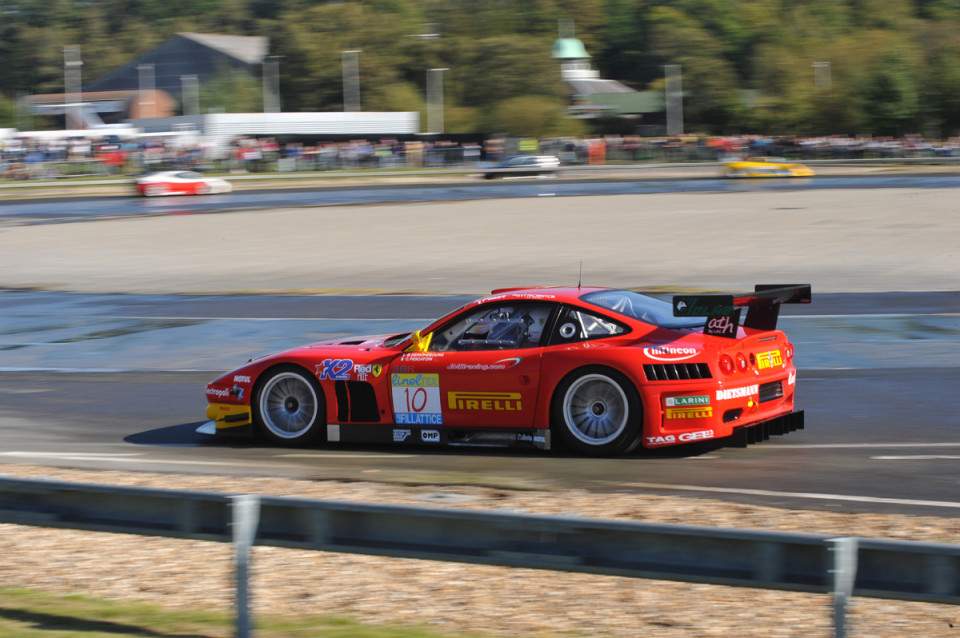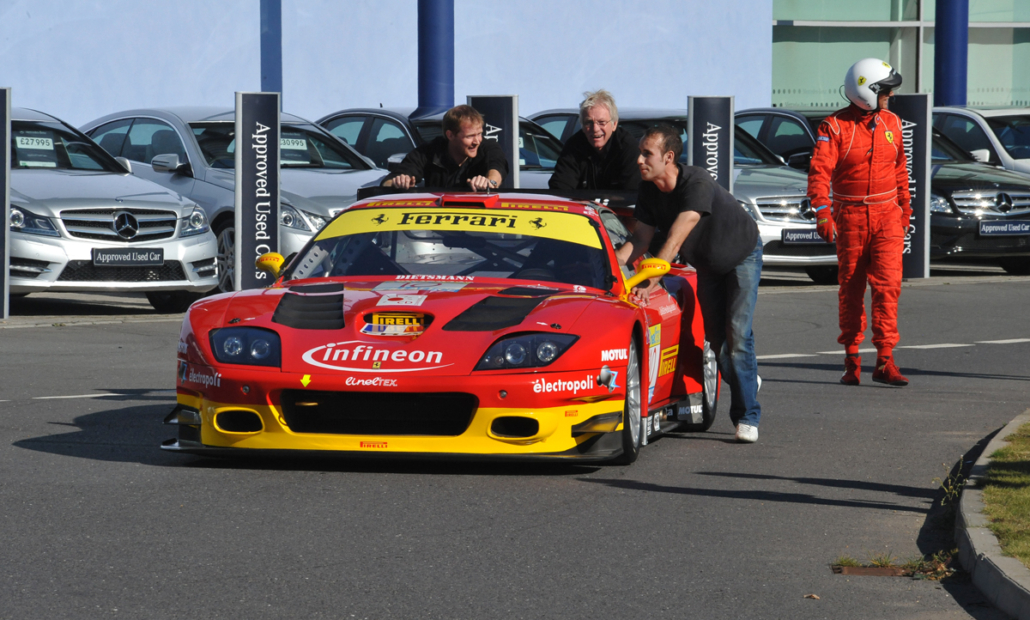
Developed by Ferrari’s Corse Clienti department in close collaboration with Michelotto Automobili, the Ferrari 575 GTC marked a bold return to front-engined V12 GT racing for the marque. Based on the road-going 575M Maranello, the GTC was extensively reengineered to compete in the FIA GT1 category, with enhancements focused on performance, durability, and aerodynamic efficiency for endurance racing.
One of the most striking aspects of the 575 GTC was its aerodynamic redesign, shaped through rigorous wind tunnel testing. Featuring a widened track, a deep front splitter, flat underbody, and an aggressively mounted rear wing, the car delivered significant increases in downforce, improving high-speed stability and cornering performance. The use of lightweight composite materials and stripped-down interiors brought the car’s weight down to 1,100 kg, the regulatory minimum, while maintaining the strength and rigidity essential for competitive endurance racing.
Powered by a race-prepared version of Ferrari’s 5.5-litre V12, producing around 600 bhp, the 575 GTC saw action in prominent international championships, including the FIA GT Championship and Le Mans Series, where it competed against the best GT machinery of its era. Though only a limited number were built it remains a symbol of Ferrari’s commitment to front-engined GT racing and is now highly prized by collectors and historic racing enthusiasts alike for its rarity, performance, and raw mechanical presence.
Above is the 575 GTC recommissioned by SB Race Engineering in 2010.


Ferrari 575 GTC Technical Specifications
| ENGINE | |||
| type | front, longitudinal 65° V12 | ||
| bore/stroke | 90 x 78.56 mm | ||
| unitary displacement | 499.77 cc | ||
| total displacement | 5997.32 cc | ||
| compression ratio | 12,9:1 | ||
| maximum power | 445 kW (605 hp) at 6300 rpm | ||
| power per litre | 101 hp/l | ||
| maximum torque | 730 Nm (74 kgm) at 5200 rpm | ||
| valve actuation | twin overhead camshafts per bank, four valves per cylinder | ||
| fuel feed | Magneti Marelli electronic injection | ||
| ignition | Magneti Marelli electronic, single spark plug per cylinder | ||
| lubrication | dry sump | ||
| clutch | multi-plate | ||
| CHASSIS | |||
| frame | tubular steel with composite panels | ||
| front suspension | independent, unequal-length wishbones, coil springs, telescopic shock absorbers, anti-roll bar | ||
| rear suspension | independent, unequal-length wishbones, coil springs, telescopic shock absorbers, anti-roll bar | ||
| brakes | discs | ||
| transmission | sequential 6-speed + reverse | ||
| steering | rack-and-pinion | ||
| fuel tank | capacity 100 litres | ||
| front tyres | 325/650 x 18 | ||
| rear tyres | 325/705 x 18 | ||
| BODYWORK | |||
| type | two-seater berlinetta | ||
| length | 4590 mm | ||
| width | 2035 mm | ||
| height | 1170 mm | ||
| wheelbase | 2500 mm | ||
| front track | 1706 mm | ||
| rear track | 1682 mm | ||
| weight | 1150 kg (dry) | ||
| PERFORMANCE | |||
| top speed | - | ||
| acceleration 0-100 km/h | - | ||
| 0-400 m | - | ||
| 0-1000 m | - | ||
Ferrari 575 GTC Today.
Though built in very limited numbers—fewer than 12 factory-supported cars—the 575 GTC competed in top-level international championships, including the FIA GT Championship and Le Mans Series, where it demonstrated both performance and presence against the strongest GT grids of the era.
By 2025, values for the 575 GTC typically range from £400,000 to £600,000, depending on originality, race history, and condition. It remains one of the rarest and most desirable factory-developed Ferrari GT racers of the modern era. At SB Race Engineering, we are proud to have supported these cars both in-period and in their current historic roles. Our team offers expert maintenance, restoration, and race support, drawing on years of hands-on experience with the platform. Whether for display, testing, or competitive use, we ensure each 575 GTC is prepared to the highest standard. Discover more about our services on our Track Preparation page.

